The Berghia nudibranch, an outstanding natural way to control the aiptasia anemone
“The enemy of my enemy is my friend” (ancient proverb)
Those words sum up the essence of why the Berghia Nudibranch, Berghia stephanieae, is so popular in the aquarium hobby.
The dreaded and maligned aiptasia anemone is generally considered to be an uninvited and invasive pest. They are supremely adapted to survive in our tanks and reproduce with reckless abandon, stinging our invited guests (the corals) into submission.
They’re actually quite beautiful. Check out this large adult in the video below.
Table of contents
- Products to help you control aiptasia anemones
- What is a Berghia nudibranch?
- How do you pronounce the name, “Berghia nudibranch?”
- What do they eat?
- How many Berghia nudibranchs do you need per tank?
- Breeding them
- How long will it take to clear the tank of aiptasia?
- Are they reef safe?
- Where to buy?
Products to buy that can help you control aiptasia anemones
There are a few commercially available products to help control the spread of these pests, like Aiptasia X:
Another popular product is called Joe’s Juice:
But the process involves injecting the unsuspecting invertebrates with a lethal chemical injection–one, by one, by one, by one, by one. If your tank reaches plague proportions, you would have to quit your day job, if you wanted to eliminate them from your tank.
Plus, if you’re like most of us, you may be looking for a more natural way to fight this pest in your tank.
(Enter the Berghia nudibranch)
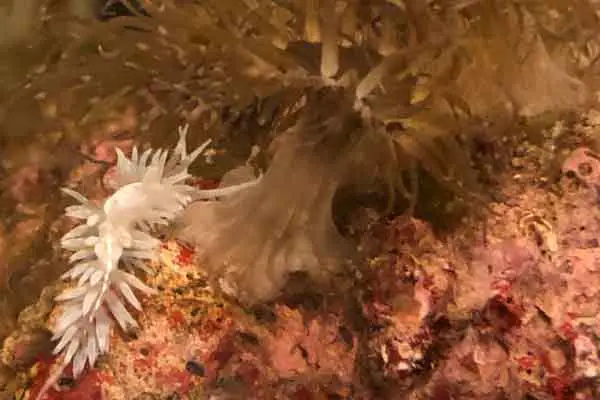
What is a Berghia Nudibranch?
The Berghia Nudibranch is a small invertebrate naturally found in the Atlantic Ocean, Caribbean and Mediterranean seas. It usually reaches about 1″ long, with some individuals growing slightly larger. Their backs are covered with tiny tassels called cerata.
How do you pronounce “Berghia Nudibranch”?
Let’s start with the hard-hitting questions: how do you even pronounce “Berghia Nudibranch”?
(BURG-ee-uh)
What do you call more than one?
If you have one, you have a Berghia Nudibranch. If you have two or more, you have Nudibranchs
What do they eat?
The Berghia Nudibranch is a specialized predator that only eats Aiptasia anemones. This is exactly why they are popularly added to our tanks as a natural way to control aiptasia.
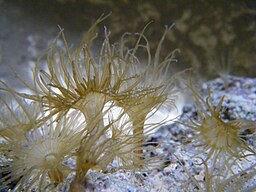
If you have an extra minute or two, check out this video of this hungry invertebrate in action chowing down on aiptasia:
When you first introduce the Berghia nudibranchs to your tank, they will need to find and take down their first meal within about a week, or they risk starving. Depending on the size of your tank and the density of your anemone problem, that could seriously happen, which is why the retailers will recommend you place them very gently right near a targeted prey or area with some anemones.
Interesting facts
- Here is an interesting fact–did you know that Berghia nudibranchs store up the undigested stinging cells (nematocysts) in the pouches on their back? Bet you that stings.
- Their total lifespan is about one year or less
- They do best with high-quality reef tank water parameters
How big are they?
They are sold by aquaculture facilities/breeders anywhere from 1/4-inch in length to about 3/4-inches in length. They are sexually mature (and therefore able to reproduce) at about 1/2-inch in length and grow to a full adult size of about 1 1/2-inches in total length.
When I purchased several medium-sized adults, I found that there was quite a distribution in sizes. Their size will also swell a bit after a good meal. After about a month in the tank feasting on aiptasia, one individual was pushing about an inch in total length
How many Berghia nudibranchs per tank?
Berghia nudibranchs need each other–for hunting and for reproduction. They need each other to take down a full-sized anemone, and while they are hermaphroditic, they do require another slug to successfully mate.
Also, depending on the severity of your aiptasia issue, you’re probably going to need an entire ‘population’ of slugs to address the problem. That means you need to have lots of eggs and sea slug babies. So the more you start off with, the faster your population will grow.
The two sites specializing in selling Berghia nudibranchs recommend no less than 6 per tank (in any size tank) and otherwise approximately 1 for every 10-12 gallons of aquarium volume. The rationale for this is that if you hope to eliminate aiptasia from your tank, the invertebrates will need to find each other to gang up on each individual anemone (that’s how they hunt and take down an anemone) and they will need to find each other to mate and reproduce. The original population is likely insufficient to eradicate the anemone pests, but it is when you have established future generations of the sea slug that you will reach a level where elimination can be obtained.
If you don’t order enough, they could starve or get eaten (by shrimp, crabs, wrasses, etc.) before they reach a population size suitable to complete the task.
Behavior and tank mates
Berghia nudibranchs will not harm corals or other invertebrates. They will only eat aiptasia anemones. In fact, they won’t even eat Majano anemones (a close cousin of the aiptasia).
Will fish eat Berghia nudibranchs?
The majority of saltwater aquarium fish will not eat Berghia nudibranchs, but there are several species that will.
If you have a Melanurus wrasse, six-line wrasse, Aiptasia-eating filefish, or a long-nose hawkfish, you may want to think twice about adding them to your tank, since the Berghia will be a nice little appetizer for them.
Will shrimp eat Berghia nudibranchs?
Yes, certain popular aquarium shrimp species will eat Berghia nudibranchs. Peppermint shrimp, added to tanks because of their taste for aiptasia flesh, also eat Berghia nudibranchs, which seems ironic to me. Especially because you wouldn’t need to add both if the much more readily available peppermint shrimp just did their job in the first place.
Coral banded shrimp may also be problematic.
It is a bit ironic to me, but if you have any other aiptasia-predators in the tank, they will also very likely be nudibranch hunters as well. I guess it’s an eat aiptasia or be eaten world in the ocean.
Will crabs eat Berghia nudibranchs?
Yes, a few popular aquarium crabs will eat Berghia nudibranchs, including Arrow crabs, Emerald crabs and Sally Lightfoot crabs.
Learn more about arrow or emerald crabs.
Breeding
Berghia Nudibranchs will mate and lay eggs once they reach maturity. It is generally recommended to start with the 1/2 inch size, to ensure the best chance of establishing a breeding population in your tank. A breeding Berghia nudibranch lays eggs once every few days (1-3 or 1-4). Each egg coil probably contains ~50 eggs (if laid by a small slug) or 1000+ if laid by a larger adult. The eggs are generally laid in a spiral pattern in an ‘out-of-the-way’ location.
The eggs take about 2-weeks to hatch under normal aquarium temperatures.
The picture above shows the characteristic spiral shape, with the slug right there in view as the eggs were laid in the grass. But they don’t always lay them on the glass. They will also lay them inside crevices in the live rock, like below:
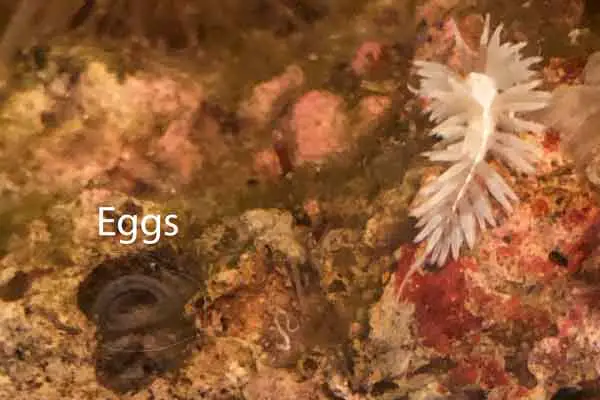
If you are seriously interested in breeding these sea slugs, there is a book you can get:
Although, I do caution you to read some of the reviews. There are mixed opinions about how helpful this book either is or is not. I will share excerpts from one good and one bad review. See if you can figure out which is which:
“The book is great…..a little long on the introduction but the following information, articles, and descriptions are great!” -Paul
“…little useful information. This is the worst piece of hobby literature I can recall reading…” – Anthony C.
How long will it take to clear my tank of aiptasia?
If all goes well, it will probably take about 3 months, or longer, to mostly clear your tank of the pest anemones. Adding the predatory nudi’s to your tank will not be an overnight success. They will slowly and methodically graze on the anemones, while the anemones and nudibranchs continue to reproduce.
While aiptasia reproduction can be frustrating, they generally don’t reproduce as dramatically as the hermaphroditic, egg-laying nudibranchs are capable of. As a result, the nudibranch population should hopefully increase rapidly enough to overtake your anemone problem.
Are they reef safe?
Yes, they are reef safe towards every invertebrate except the aiptasia anemones they eat. Way safer than the Copperband butterflyfish or even the Peppermint shrimp, both of which are occasionally reported to be problematic towards certain coral species. Unlike other sea slugs, like aplysia, they will not ink up your tank.
Where did they go, did they disappear?
It is very common that your Berghia nudibranchs will disappear shortly after being added to your tank. They are cryptic and generally hide during the day and hunt aiptasia at night.
Acclimating Berghia nudibranchs
It is recommended that you acclimate and treat your new Berghia nudibranchs like the fragile and expensive marine invertebrates they are.
Step 1: Equilibrate the temperature with your tank, slowly, by floating the container in your display tank or sump for ~10-20 minutes
Step 2: Using a Drip acclimator, and a gravity drip, start dripping water into the container (about 6-10 drips per second) for about an hour, in total
Step 3: Manually place the nudibranchs on a rock adjacent to aiptasia
Tips: To reduce the risk that your aquarium fish or inverts try to dine on your new aiptasia-hunters, you may want to stuff them, first, about 30-minutes into your drip acclimation and then turn off the lights.
Check out this video:
Where to buy them
Because Berghia nudibranch’s need a constant supply of aiptasia anemones to survive, they may not be in stock at your local fish store. It’s not to say that your local fish store wouldn’t benefit from them.
After all, how did you get the aiptasia in your tank, to begin with? But I suppose seeing a bunch of Berghia swimming around would send a negative message to shoppers.
If your local fish store doesn’t have them, you can pick them up online.
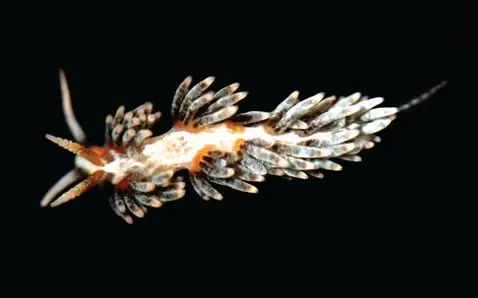
For more information
The Berghia nudibranch is usually purchased specifically to handle the pesky and dreaded aiptasia anemone. A better choice for many tanks might be the peppermint shrimp.
Learn more about caring for the peppermint shrimp here.
Or
If you want to continue to learn more about other common aquarium pests, check out these other articles:
How to get rid of green hair algae
Or check out this video to learn more about the Berghia nudibranchs







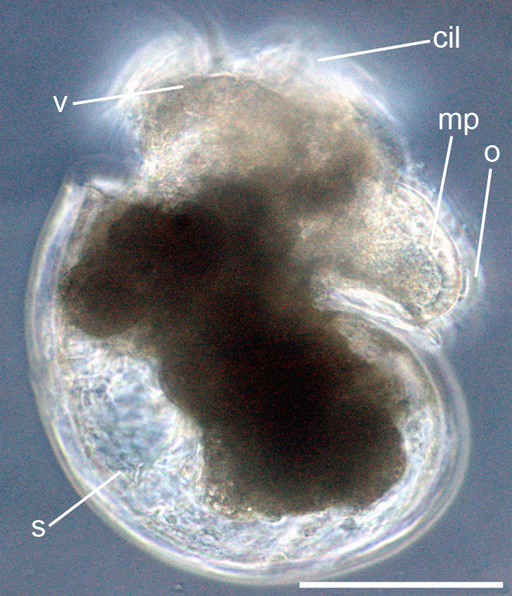


Leave a Reply